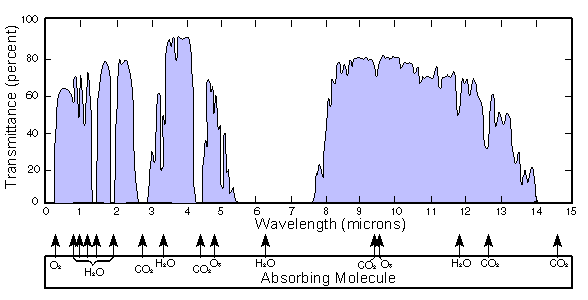
M band
Encyclopedia
M band can refer to two different regions of the electromagnetic spectrum, in the radio and near-infrared.
from 60 GHz
to 100 GHz in the electromagnetic spectrum
. This is equal to wave lengths between 5 mm and 3 mm. The M band is in the EHF
range of the radio spectrum
.
The modern M band intersects with the V
(50–75 GHz) and W band
(75–110 GHz) of the older IEEE classification system.
 In infrared astronomy
In infrared astronomy
, the M band refers to an atmospheric transmission window centred on 4.7 micrometres (in the mid-infrared).
Radio
The M band is the range of radio frequenciesRadio frequency
Radio frequency is a rate of oscillation in the range of about 3 kHz to 300 GHz, which corresponds to the frequency of radio waves, and the alternating currents which carry radio signals...
from 60 GHz
Hertz
The hertz is the SI unit of frequency defined as the number of cycles per second of a periodic phenomenon. One of its most common uses is the description of the sine wave, particularly those used in radio and audio applications....
to 100 GHz in the electromagnetic spectrum
Electromagnetic spectrum
The electromagnetic spectrum is the range of all possible frequencies of electromagnetic radiation. The "electromagnetic spectrum" of an object is the characteristic distribution of electromagnetic radiation emitted or absorbed by that particular object....
. This is equal to wave lengths between 5 mm and 3 mm. The M band is in the EHF
Extremely high frequency
Extremely high frequency is the highest radio frequency band. EHF runs the range of frequencies from 30 to 300 gigahertz, above which electromagnetic radiation is considered to be low infrared light, also referred to as terahertz radiation...
range of the radio spectrum
Radio spectrum
Radio spectrum refers to the part of the electromagnetic spectrum corresponding to radio frequencies – that is, frequencies lower than around 300 GHz ....
.
The modern M band intersects with the V
V band
The V band of the electromagnetic spectrum ranges from 50 to 75 GHz. The V band is not heavily used, except for millimeter wave radar research and other kinds of scientific research...
(50–75 GHz) and W band
W band
The W band of the microwave part of the electromagnetic spectrum ranges from 75 to 110 GHz. It sits above the U.S. IEEE designated V band in frequency, yet overlaps the NATO designated M band...
(75–110 GHz) of the older IEEE classification system.
Infrared astronomy

Infrared astronomy
Infrared astronomy is the branch of astronomy and astrophysics that studies astronomical objects visible in infrared radiation. The wavelength of infrared light ranges from 0.75 to 300 micrometers...
, the M band refers to an atmospheric transmission window centred on 4.7 micrometres (in the mid-infrared).

